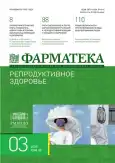Предикторы инфицирования резистентными возбудителями и возможности стратификации риска в оперативном акушерстве
- Авторы: Коробков Н.А.1, Кахиани Е.И.1, Олина А.А.1, Дудниченко Т.А.1, Толибова Г.Х.1, Сигуа Б.В.1
-
Учреждения:
- Северо-Западный государственный медицинский университет имени И.И. Мечникова
- Выпуск: Том 32, № 3 (2025)
- Страницы: 62-67
- Раздел: Оригинальные статьи
- Статья опубликована: 13.08.2025
- URL: https://journals.eco-vector.com/2073-4034/article/view/688956
- DOI: https://doi.org/10.18565/pharmateca.2025.3.62-67
- ID: 688956
Цитировать
Полный текст
Аннотация
Цель исследования: выявить наиболее значимые предикторы инфицирования антибиотикорезистентными возбудителями родильниц с эндометритом после абдоминального родоразрешения.
Материалы и методы: Ретроспективный анализ 648 случаев кесарева сечения (406 – эндометрит после кесарева сечения, 242 – неосложненный послеоперационный период) и результатов микробиологического исследования лохий (идентификация микроорганизмов и определение антибиотикограммы). Рассчитывали количество сопутствующих экстрагенитальных заболеваний по кумулятивной шкале рейтинга заболеваний (CIRS).
Результаты: Верифицировано 106 (26,1%) лекарственно-устойчивых изолятов при эндометрите после КС (р<0,001). У каждой шестой родильницы (16,8%) с эндометритом выделены MDR-штаммы группы rESKAPE.
Самая низкая (25%) и самая высокая (97%) распространенность чувствительности наблюдались при применении клиндамицина и ванкомицина соответственно. К основным лекарственно-устойчивым возбудителям отнесены грамотрицательные ESBL-продуценты порядка Enterobacterales.
Подавляющее большинство основных предикторов развития эндометрита после абдоминального родоразрешения также связаны с отягощенным соматическим фоном: экстренным КС в родах при длительном безводном промежутке ≥12 ч, суммой 4 балла и более по системе CIRS, анемией воспаления/хронического заболевания, экстрагенитальными инфекциями при данной беременности, наличием цервикального серкляжа/пессария, индексом массы тела ≥30,00 кг/м2, бессимптомной бактериурией и уровнем глюкозы в венозной плазме натощак при беременности >5,1 ммоль/л.
Заключение: Коморбидность (4 балла и более по системе CIRS) служит наиболее надежным предиктором колонизации полирезистентными возбудителями и фактором риска развития эндометрита после КС. Важный предиктор выделения MDR-возбудителей – экстренное КС в сочетании с длительным (≥12 ч) безводным промежутком и длительной (≥10 ч) родовой деятельностью перед операцией. На риск носительства лекарственно-устойчивых штаммов влияют: «антибактериальный анамнез» и госпитализации/инвазивные процедуры или операции во второй половине беременности.
Ключевые слова
Полный текст
Об авторах
Николай Александрович Коробков
Северо-Западный государственный медицинский университет имени И.И. Мечникова
Автор, ответственный за переписку.
Email: nikolai_korobkov@mail.ru
к.м.н., доцент кафедры акушерства и гинекологии им. С.Н. Давыдова
Россия, Санкт-ПетербургЕкатерина Инвериевна Кахиани
Северо-Западный государственный медицинский университет имени И.И. Мечникова
Email: nikolai_korobkov@mail.ru
ORCID iD: 0000-0002-0410-817X
д.м.н., профессор, зав. кафедрой акушерства и гинекологии им. С.Н. Давыдова
Россия, Санкт-ПетербургАнна Александровна Олина
Северо-Западный государственный медицинский университет имени И.И. Мечникова
Email: nikolai_korobkov@mail.ru
ORCID iD: 0000-0001-9101-7569
д.м.н., профессор, профессор кафедры акушерства и гинекологии им. С.Н. Давыдова
Россия, Санкт-ПетербургТатьяна Александровна Дудниченко
Северо-Западный государственный медицинский университет имени И.И. Мечникова
Email: nikolai_korobkov@mail.ru
ORCID iD: 0000-0001-7111-1283
к.м.н., доцент, доцент кафедры акушерства и гинекологии им. С.Н. Давыдова
Россия, Санкт-ПетербургГулрухсор Хайбуллоевна Толибова
Северо-Западный государственный медицинский университет имени И.И. Мечникова
Email: nikolai_korobkov@mail.ru
ORCID iD: 0000-0002-6216-6220
д.м.н., профессор кафедры акушерства и гинекологии им. С.Н. Давыдова
Россия, Санкт-ПетербургБадри Валериевич Сигуа
Северо-Западный государственный медицинский университет имени И.И. Мечникова
Email: nikolai_korobkov@mail.ru
ORCID iD: 0000-0002-4556-4913
д.м.н., профессор, профессор кафедры факультетской хирургии с курсом эндоскопии им. И.И. Грекова
Россия, Санкт-ПетербургСписок литературы
- Brink A.J., Richards G. Best practice: antibiotic decision-making in ICUs. Curr Opin Crit Care. 2020;26(5):478–488. https://dx.doi.org/10.1097/MCC.0000000000000752
- Zahar J.R., Timsit J.F. Risk stratification for selecting empiric antibiotherapy during and after COVID-19. Curr Opin Infect Dis. 2022;35(6):605–613. https://dx.doi.org/10.1097/QCO.0000000000000881
- Яковлев С.Я., Журавлева М.В., Проценко Д.Н. и др. Программа СКАТ (Стратегия Контроля Антимикробной Терапии) при оказании стационарной медицинской помощи. Методические рекомендации для лечебно-профилактических учреждений Москвы. Consilium Medicum. 2017;19(7.1. Хирургия):15–51. [Yakovlev S.V., Zhuravleva M.V., Protsenko D.N. et al. Antibiotic stewardship program for inpatient care. Clinical guidelines for Moscow hospitals. Consilium Medicum. 2017;19(7.1. Surgery):15–51. (In Russ.)]
- Белобородов В.Б., Гусаров В.Г., Дехнич А.В. и др. Диагностика и антимикробная терапия инфекций, вызванных полирезистентными микроорганизмами. Методические рекомендации. Вестник анестезиологии и реаниматологии. 2020;17(1):52–83. [Beloborodov V.B., Gusarov V.G., Dekhnich A.V. et al. Diagnostics and antimicrobial therapy of infections caused by multidrug-resistant microorganisms. Guidelines. Bulletin of Anesthesiology and Resuscitation. 2020;17(1):52–83. (In Russ.)]. https://dx.doi.org/10.21292/2078-5658-2020-17-1-52-83
- Ledger W.J., Blaser M.J. Are we using too many antibiotics during pregnancy? BJOG. 2013; 120:1450–1452. https://dx.doi.org/10.1111/1471-0528.12371
- WHO model list of essential medicines. 20th list (March 2017) Geneva: World Health Organization; 2021. URL: https://iris.who.int/handle/10665/273826
- Resolution A/RES/71/3 Adopted by the General Assembly on 5 October 2016. Political declaration of the high-level meeting of the General Assembly on antimicrobial resistance. Available from: http://www.who.int/antimicrobialresistance/interagency-coordination-group/UNGA-AMRRES-71-3-N1631065.pdf?ua=1
- De Waele J.J., Akova M., Antonelli M., et al. Antimicrobial resistance and antibiotic stewardship programs in the ICU: insistence and persistence in the fight against resistance. A position statement from ESICM/ESCMID/WAAAR round table on multidrug resistance. Intensive Care Med. 2018;44:189–196. https://dx.doi.org/10.1007/s00134-017-5036-1
- Jung E., Romero R., Yeo L. The fetal inflammatory response syndrome: the origins of a concept, pathophysiology, diagnosis, and obstetrical implications Semin Fetal Neonatal Med. 2020;25(4):101146. https://dx.doi.org/10.1016/j.siny.2020.101146
Дополнительные файлы









